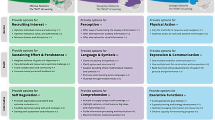Abstract
In an open e-learning content management environment, relation metadata is of benefit to improve semantic organization and reusability of learning content. Although the suggested relations defined in the SCORM and the extended relations proposed in the past studies can describe semantic relationships, there are some new requirements of semantic organization and utilization of open learning content. Based on existing models, this paper presents an extended relation metadata model for open knowledge communities. In order to help users to author and utilize the semantic relation, the visual authoring system named web-based visual authoring system for relation metadata (WVAS-RM) in the Learning Cell Knowledge Community is designed and implemented to assist the construction and utilization of semantic relations of Learning Cells. The paper presents an empirical evaluation of the teachers’ and learners’ acceptance and satisfaction of the proposed system using the adapted Technology Acceptance Model and System Usability Scale. The semi-structured interviews are also carried out with participants including teachers and students. It is concluded that students and teachers feel confident and satisfied with the system.








Similar content being viewed by others
Notes
vis.js - A dynamic, browser based visualization library. http://visjs.org/.
References
Brooke J (1996) Sus-a quick and dirty usability scale. Usability Evaluation in Industry 189:4–7
Burkhard RA (2004) Learning from architects: the difference between knowledge visualization and information visualization. In: IV ‘04: Proceedings of the Information Visualisation, Eighth International Conference, IEEE Comput. Soc, pp 519–524
Curlango-Rosas C, Ponce GA, Lopez-Morteo GA (2011) A specialized search assistant for learning objects. ACM Trans Web 5(4):1–29
Davis FD (1989) Perceived usefulness, perceived ease of use and user acceptance of information technology. MIS Q 13(3):319–340
Downes S (2001) Learning objects: resources for distance education worldwide. International Review of Research in Open & Distance Learning 2:1
Duval E, Hodgins W (2003) A LOM research agenda. In: Hencsey G, White B, Chen Y, Kovacs L, Lawrence S (eds.) Proceedings of the 12th international conference on World Wide Web. Budapest, Hungary, pp. 659–667
Fischer S (2001) Course and exercise sequencing using metadata in adaptive hypermedia learning systems. ACM Journal of Education Resource in Computing 1(1):1–21
Harrati N, Bouchrika I, Tari A, Ladjailia A (2016) Exploring user satisfaction for e-learning systems via usage-based metrics and system usability scale analysis. Comput Hum Behav 61:463–471
Huang TC, Chen CC (2013) Animating civic education: developing a knowledge navigation system using blogging and topic map technology. Educ Technol Soc 16(1):79–92
Karger P, Ullrich C, Melis E (2006) Integrating learning object repositories using a mediator architecture. Paper presented at the First European Conference on Technology Enhanced Learning, Crete
Liu IF, Chen MC, Sun YS, Wible D, Kuo C (2010) Extending the TAM model to explore the factors that affect intention to use an online learning community. Comput Educ 54(2):600–610
Lu JL, Hsieh CJ (2009) A relation metadata extension for scorm content aggregation model. Computer Standards & Interfaces 31(5):1028–1035
Lu JL, Horng G, Yu CS, Chou LY (2010) Extended relation metadata for scorm-based learning content management systems. Educ Technol Soc 13(1):220–235
Mann WC, Thompson SA (1988) Rhetorical structure theory: toward a functional theory of text organization. Text 8(3):243–281
Müller D, Yi MY (2014) Annotating korean text documents with linked data resources. Multimed Tools Appl 68(2):413–427
Ngai E, Poon J, Chan Y (2007) Empirical examination of the adoption of WebCT using TAM. Comput Educ 48:250–267
Persico D, Manca S, Pozzi F (2014) Adapting the technology acceptance model to evaluate the innovative potential of elearning systems. Comput Hum Behav 30:614–622
Reigeluth C (1999) Instructional-design theories and models, volume II: a new paradigm of instructional theory. Lawrence Erlbaum, Mahwah
Robles-Gómez A, Ros S, Hernández R, Tobarra L, Caminero AC, Agudo JM (2015) User acceptance of a proposed self-evaluation and continuous assessment system. Educ Technol Soc 18(2):97–109
Sddik AE, Fischer S, Steinmetz R (2001) Reusable multimedia content in web-based learning systems. IEEE Multimedia 8(3):30–38
Shee D, Wang Y (2008) Multi-criteria evaluation of the web-based e-learning system: a methodology based on learner satisfaction and its applications. Comput Educ 50:894–905
Steinacker A, Faatz A, Seeberg C, Rimac L, Hormann S, Saddik AE, Steinmetz R (2001) Medibook: combining semantic networks metadata for learning resources to build a web based learning system. Paper presented at the Ed-Media Conference, Tampere
Tergan SO, Keller T, Burkhard RA (2006) Integrating knowledge and information: digital concept maps as bridging technology. Inf Vis 5(3):167–174
Tiropanis T, Davis H, Millard D, Weal M (2009) Semantic technologies for learning and teaching in the web 2.0 era. IEEE Intell Syst 24(6):49–53
Ullrich C (2004) Description of an instructional ontology and its application in web services for education. Paper presented at the Workshop on Application of Semantic Web Technologies for E-learning, Hiroshima
Verbert K, Duval E (2008) Alocom: a generic content model for learning objects. Int J Digit Libr 9(1):41–63
Wang M, Peng J, Cheng B, Zhou H, Liu J (2011) Knowledge visualization for self-regulated learning. Educ Technol Soc 14(3):28–42
Wu P, Yu S (2015) Design of a Novel Intelligent Framework for finding experts and learning peers in open knowledge communities. EAI Endorsed Transactions on Future Intelligent Educational Environments 15(2):e4
Yang X, Qiu Q, Yu S, Tahir H (2014) Designing a trust evaluation model for open-knowledge communities. Br J Educ Technol 45(5):880–901
Yu S, Yang X, Cheng G, Wang M (2015) From learning object to learning cell: a resource organization model for ubiquitous learning. Educ Technol Soc 18(2):206–224
Acknowledgements
This research was funded by the project “the Research on Internet plus Educational System” (Project No.16JZD043).
Author information
Authors and Affiliations
Corresponding author
Rights and permissions
About this article
Cite this article
Wu, P., Yu, S., Ren, N. et al. Development of a visual e-learning system for supporting the semantic organization and utilization of open learning content. Multimed Tools Appl 77, 17437–17456 (2018). https://doi.org/10.1007/s11042-017-5312-7
Received:
Revised:
Accepted:
Published:
Issue Date:
DOI: https://doi.org/10.1007/s11042-017-5312-7




